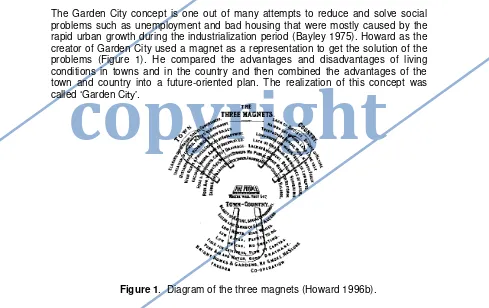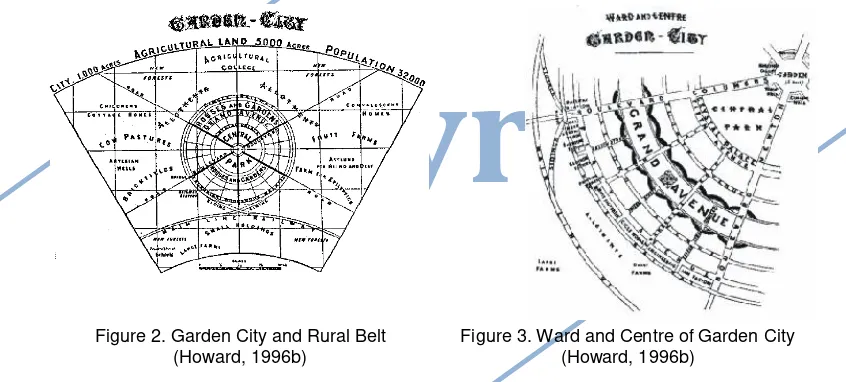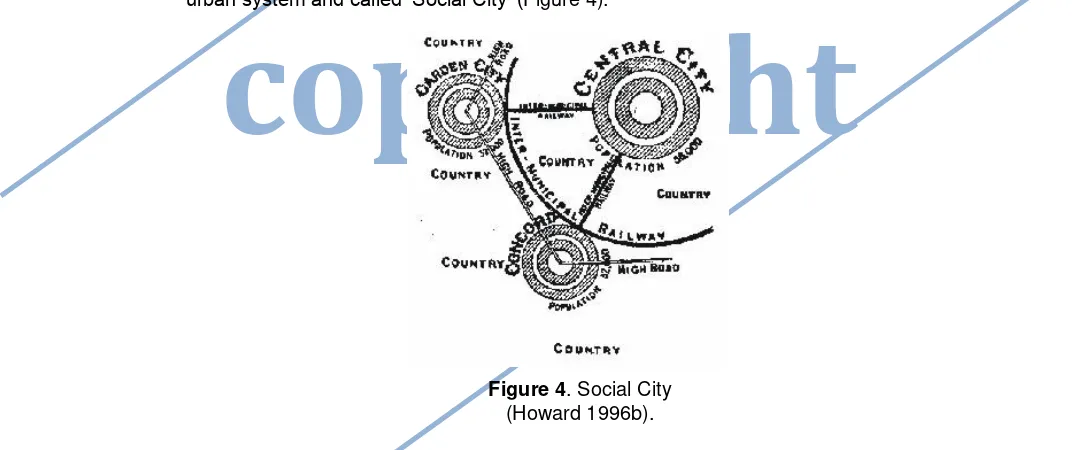17
copyright
‘GARDEN CITY’: THE SUITABILITY OF ITS PRINCIPLES AS A MODEL TO THECONTEMPORARY PLANNING
Evalina Z. dan Husnus Sawab
Jurusan Arsitektur Universitas Syiah Kula Banda Aceh
Evalinaz_lgs@yahoo.co.id & Husnussawab@yahoo.com
ABSTRACT. Garden City is an urban planning concept that adopted from of Ebenezer Howard who developed the idea of garden cities as a way towards a better and brighter civilization. This article discuss the Garden City concept as associated to planning evolution and describes the later changes in approach to planning better cities in current circumstances. Based on arguments from some experts and evidence derived from practice, Garden City is the novel idea that has a unique presentation because of its simplicity and range of details which consist of three main elements including decentralization, garden and city or in simple terms are location, physical design and community ownership. These days, while in some extent the Garden City idea is still attractive especially in terms of the idea of green design and social city model, the appropriateness of the Garden City idea to contemporary planning seems invalid. The Garden City concepts such as decentralization, low density, self-containment communities, new settlements and proportion of population to land are not anymore fit with current situation which is urban population growth rapidly imbalance with land availability. Urban concept today tends to consider environmental approach in order to gain sustainable goals such as ‘compact city’ concept in planning the better city. The Garden City has a valuable contribution to evolution of urban and regional planning approach, but it is not entirely relevant to the contemporary planning approach.
Keywords: Garden City, Contemporary Planning
18
copyright
Garden city adalah sebuah konsep awal yang memiliki sebuah keunikan dikarenakan kesederhanaannya dan detil yang beragam. Konsep Garden city terdiri dari 3 (tiga) elemen utama, yaitu: desentralisasi, garden dan city atau dengan istilah lain adalah lokasi, desain fisik, dan kepemililkan masyarakat (community ownership). Konsep Garden City sampai saat ini cukup mendapat perhatian terkait dengan konsep green design dan social city model. Tetapi, beberapa konsep lainnya dari Garden City seperti, disentralisasi, tingkat kepadatan yang rendah, masyarakat mandiri, pemukiman baru, dan proporsi jumlah penduduk terhadap lahan tidak sesuai dengan situasi saat ini dimana pertumbuhan penduduk kota yang sangat cepat tidak seimbang dengan ketersediaan lahan. Konsep perkotaan masa kini cenderung mempertimbangkan pendekatan lingkungan untuk mencapai sustainable goals seperti, konsep compact city dalam merencanakan kota yang lebih baik. Konsep Garden City memiliki kontribusi yang bernilai terhadap perkembangan pendekatan perencanaan kota dan wilayah, tetapi tidak secara keseluruhannya relevan pada pendekatan perencanaan masa kini.Keywords: Kota Taman, Perencanaan masa kini
INTRODUCTION
The Garden City concept in urban planning takes its name from the work of Ebenezer Howard, who in his book To-Morrow: A peaceful path to realm reform (1898) developed the idea of garden cities as a way towards ‘a better and brighter civilization’ (Freestone 1989b). Howard’s argument begins with a protest against urban overcrowding and the conditions which existed in industrial countries mainly in Europe in the 19th century (Howard 1996a).
19
copyright
The article consists of three distinct parts. The first part explains the main elements of the Garden City concept in terms of its uniqueness, and how is it a novel design. Then the second part seeks to question the suitability of ‘Garden City’ as a model for contemporary planning. The last part of the article briefly explains the recent changes in emphasis and approach to planning in terms of environmental awareness.THE MAIN ELEMENTS OF THE GARDEN CITY CONCEPT
The Garden City concept is one out of many attempts to reduce and solve social problems such as unemployment and bad housing that were mostly caused by the rapid urban growth during the industrialization period (Bayley 1975). Howard as the creator of Garden City used a magnet as a representation to get the solution of the problems (Figure 1). He compared the advantages and disadvantages of living conditions in towns and in the country and then combined the advantages of the town and country into a future-oriented plan. The realization of this concept was called ‘Garden City’.
Figure 1. Diagram of the three magnets (Howard 1996b).
20
copyright
made in one stroke an apparently idealized and impractical format feasible within the contemporary political and social circumstance. Also, Howard’s insightful understanding of his own society was so great as to confer on him the power to bring an innovative concept out of the realm of idea and into the realm of material realization (Batchelor 1969).In general, the Garden City tradition has three main elements (Batchelor 1969; Fishman 1989; Hebbert 1989). The first element is the decentralization idea (location), the social process in which population and industry moves from urban centers to distant districts. As Howard put it in 1904, the 20th century would be the age of the ‘great exodus’ from the ‘closely-compacted, over-crowded, city’.
Figure 2. Garden City and Rural Belt (Howard, 1996b)
Figure 3. Ward and Centre of Garden City (Howard, 1996b)
21
copyright
area, surrounded by official buildings and cultural institutions. This central section is surrounded by a broad central park which is bordered by a circular glass palace in which the shopping area is to be found. This is followed by concentric strips which make up the residential area, consisting of small detached single- family dwellings with gardens. The plots are narrow and range from 6x300-40 meters in size. The residential area is divided by a broad boulevard, the ‘Grand Avenue’, which is enclosed by terrace houses. Factories, warehouses and markets are to be found on the outermost ring of the garden city. These are serviced by a circular railway system with tangential access to the network. A green belt extends around the garden city. This is free of structures and is reserved mostly for agricultural purposes. It guarantees the self-sufficient production of food for the city. In larger scale, several garden cities could surround a ‘central city’ which would not have more that 58,000 inhabitants. All together, the population of such urban agglomeration would be limited to 250,000. . Howard imagined his model garden city as a part of a larger urban system and called ‘Social City’ (Figure 4).Figure 4. Social City (Howard 1996b).
22
copyright
municipality; Second, the use of the unfair increase of land value in order to help the community; and third, the requirement for private commercial and industrial firms to rent property and gain profits from the operation of their businesses, with some allowances made as a hedge against extreme competition on the one hand and unfair monopolization on the other hand. The community idea that is the sightless but influential forces of decentralization could and should be guided to form self-contained communities where work, residence and leisure facilities would be found in close proximity.THE SUITABILITY OF ‘GARDEN CITY’ AS A MODEL FOR CONTEMPORARY PLANNING
In the last decade of the twentieth century, the Garden City is evoked not as a period section but as a vigorous concept that might still have its applicability today. Nobody could critically claim that Howard’s proposal of garden city is still suitable in its wholeness, but the fundamental character of his proposals keeps a continuing attraction. In some extent the suitability of the garden city idea for current planning is greater than it was roughly a century ago. It is because of current attention is becoming more focused on environmental concept of ‘sustainable development’, which have comparatively same concept of balance and harmony to Howard’s concept of the social city. According to Hardy (1989), some elements of Garden City concept such as settlements of a manageable size with a sense of identity, the provision of a good living and working environment, and a way of dealing with increasing land values and of securing benefits for the whole community remain attractive aspirations.
23
copyright
However, many environmentalists recognize the Garden City idea as an unsustainable form of development in the environmentally conscious in terms of its concept of decentralization and low-density. The European Commission’s 1990 Green Paper on the Urban Environment offers implicit criticism by strongly pressing the case for compact big cities and disapproving of the notion of peripheral development (which would appear to include Garden Cities) on environmental and social grounds. Also, Friends of the Earth and the Policy Studies Institute (Elkin, McLAren and Hillman 1991) have criticized of the obvious wastefulness of garden city development and have argued for the keeping of high densities in existing cities.In addition, in some countries such as America, China and Japan, the relevancy of Garden City concept as a model for contemporary planning is doubtful. In America, the contentious is in relation to the Garden City’s concept of self- contained communities. Schaffer (1989) argues that the creation of self-sufficient communities surrounded by green open space as a viable policy option in America is to introduce the world of policy- making with an element of unlikely irrationality that neither intellectuals nor public officials would find attractive. Also, Garvin (1998) argues that the idea that garden city residents should purchase their food from farmers who occupy surrounding agricultural greenbelts and the idea that people should live and work in the same small community were ridiculous from the start and unrealistic for today condition. These days, most people don’t want to be trapped in company towns. They want the ability to move from job to job. They want to choose their residence based on their personal assessment of schools for their children and available shopping and recreation opportunities. They want to be able to sell their home and move elsewhere whenever they desire.
24
copyright
Similarly, the land question is also a typical problem in most of the developing countries. In Japan for instance, this problem has reflected the nature of Japanese capitalism and society that makes the notion of garden city was not really practicable in this country since it has proposed in the last century. The power of landowner, the weakness of public intervention and the individual consumption of betterment in Japan are such problems that made the concept of garden city difficult to put into practice (Watanabe 1989).
In terms of residential, the garden city environment today is not anymore the most residential ideal of the planning profession. Particularly in Australia, Freestone (1989a) argued that professional interest, popular demand and economic circumstances now progressively have more focus on alternative housing styles such as medium rather than low density developments, town houses rather than detached dwellings, recycled rather than all- new housing, urban consolidation rather than suburban spread. Also, on a larger scale, green belt and satellite town concepts are not any more in fashion because they were eventually unable to cope with the complexity and rapidity of urban change. Taken as an example of Adelaide city, metropolitan planning schemata have moved towards forms facilitating continuous growth, especially corridor plans (Alexander 1981).
Additionally, in conditions of continuing global recession, new settlement proposals in Garden City’s notion obviously appear less viable. Hardy (1989) dispute that the limited- growth compact city model is currently preferred on environmental grounds rather than the incremental peripheral expansion model. The growth occurred in compact city model can be pragmatically tacked on to existing settlements without acquiring enormous infrastructure costs (Hardy 1989).
THE RECENT CHANGES IN EMPHASIS AND APPROACH TO PLANNING OF CITIES AND REGIONS
25
copyright
generations to meet their own needs’. Sustainable development has become a slogan used internationally in promoting environmentally sound approaches to spatial and economic change. It gives emphasis to the need for thorough human behavior to conserve the desirable qualities of the physical environment.According to Jenks et al (1996) much attention recently, has focused on the relationship between urban form and sustainability, the suggestion being that the shape and density of cities can have implications for their future. Also, Newman & Kenworthy (1991) argue that there are some conditions today that need change in planning approach of city to gain sustainability. Firstly, rapid decentralization has caused the loss of landscape and the costs of providing infrastructure at a vastly increasing spatial scale. Secondly, lower density development has increased dependence on the automobile for transportation and reduced the effectiveness of public transportation. Concern are present about ever increasing traffic congestion as well as the environmental impacts and resource costs of using the private automobile, usually by the driver riding alone. From these arguments, it is suggested that the ‘compact city’ concept is the most sustainable form rather than decentralization and low- density development in Garden City’s idea.
The Compact City has been promoted as a counter approach to reduce the spread of low- density urban development and to preserve the countryside. Compact urban development should take vary from urban infill and fairly higher densities in existing community centers, to major restructuring of cities (Downs 1994). Higher density and mixed uses rationally reduce trip lengths and make public transport an attractive option (Mantell, Harper & Propst 1990). There is a suggestion that the city should be of a form and scale appropriate to walking, cycling and efficient public transport, and with a compactness that encourages social interaction (Elkin, McLaren & Hillman 1991).
CONCLUSION
26
copyright
appropriateness of the Garden City idea to contemporary planning seems invalid. The Garden City concepts such as decentralization, low density, self-containment communities, new settlements and proportion of population to land are not anymore fit with current situation which is urban population growth rapidly imbalance with land availability. Lastly, urban concept today tends to consider environmental approach in order to gain sustainable goals such as ‘compact city’ concept in planning the better city. So, the Garden City has a valuable contribution to evolution of urban and regional planning approach, but it is not entirely relevant to the contemporary planning approach.REFERENCES
Alexander, I. (1981). 'Post-war metropolitan plans', in Equity in the city, ed. PN Troy, George Allen and Unwin. Sydney. pp. 145-165.
Batchelor, P. (1969). 'The Origin of the Garden City Concept of Urban Form', The Journal of the Society of Architectural Historians, vol. 28, no. 3. pp. 184-200.
Bayley, S. (1975). The garden city, Open University Pr, Milton Keynes, England. Brundtland, GH 1987, World commission on environment and development, Oxford
University Press, Oxford.
Chinanews.cn 2006, 'Garden City's concept not fit China updated 21 February 2006, Copyright © China.org.cn., viewed 21 April 2008, <http://french.china.org.cn/english/environment/158757.htm>.
Downs, A 1994, New visions for metropolitan America, Lincoln Institute of Land Policy, Cambridge, MA.
Elkin, T, McLaren, D & Hillman, M 1991, reviving the city: towards sustainable urban development, Friends of the Earth, London.
Fishman, R 1989, 'The American garden city: still relevant?' in The garden city: past, present and future, ed. SV Ward, E&FN Spon, London, pp. 146-164.
Freestone, R 1989a, 'The Australian garden city', in The garden city: past, present and future, ed. S V.Ward, E&FN Spon, London, pp. 105-126.
Freestone, R 1989b, Model communities: the garden city movement in Australia, Nelson, Melbourne.
27
copyright
Hardy, D 1989, 'The garden city campaign: an overview', in The garden city: past,present and future, ed. SV Ward, E&FN Spon, London, pp. 187-209.
Hebbert, M 1989, 'The British garden city: metamorphosis', in The garden city: past, present and future, ed. SV Ward, E&FN Spon, London, pp. 165-186.
Howard, E 1996a, ''Author's Introduction' and 'The town-country magnet' from garden cities of to-morrow (1989)', in The city reader, eds. LeGates, T Richard & F Stout, Routledge, London, pp. 321-329.
Howard, E 1996b, ''Author introduction' and 'The town-country magnet' from Garden Cities of To-morrow (1898)', in The city reader, eds. RT LeGates & F Stout, Routledge, London, pp. 321-329.
Jenks, M, Burton, E & Williams, K 1996, The compact city: a sustainable form?, E&FN Spon, London.
Mantell, M, Harper, S & Propst, L 1990, Creating succesful communities: a guidebook to growth management strategies, Island Press, Washington D.C. Newman, PWG & Kenworthy, JR 1991, 'Transport and urban form in thirty two of the
world's principal cities', Transport Reviews, vol. 1, no. 3, pp. 249-272. Purdon, CB 1925, The building of satellite towns, Dent,
Schaffer, D 1989, 'The American garden city: lost ideals', in The garden city: past, present and future, ed. S V.Ward, E&FN Spon, London, pp. 127-145.
28


